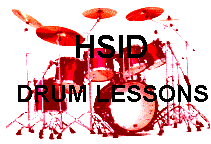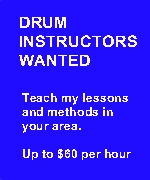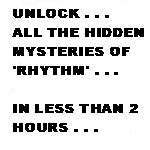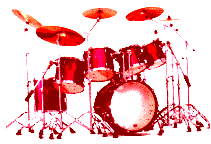 

Lesson Menu #2
Intermediate & Advanced.
Lesson Menu #3
Advanced & Ultra-Advanced.
Lesson Menu #4
Text lessons: All levels.

PRODUCTS:

GET ALL THE PRODUCTS AT ONE LOW PRICE.

SURPRISES ABOUND . . . For those with a bit of generosity
in their soul.
CLICK HERE , to see what I mean.

Intermediate & Advanced
Drummers
 Your future is waiting.
Your future is waiting.

ALL MUSICIANS
MASTER
ALL RHYTHM,
This FASCINATING WAY!
 Discover the 'LOST KEY' for Unraveling
ALL the mysteries of rhythm, and musical time.
Discover the 'LOST KEY' for Unraveling
ALL the mysteries of rhythm, and musical time.
This work
is the crowning-achievement of my 50 year career, and it's
my proudest accomplishment.
It contains the potential to help YOU change the face of modern music!
You'll love it! CLICK HERE to check it
out completely! You're in for a MAJOR surprise!
 "PRE-SCHOOL DRUMMER?
"PRE-SCHOOL DRUMMER?
YES!"
Can we teach rhythm
to pre-schoolers? YES!

This is a very short course,
designed to help adults plant the seeds of rhythm
into children of nearly any age.
CLICK HERE
 FREE ELECTRONIC BOOK BONUS (also included)
FREE ELECTRONIC BOOK BONUS (also included)
 BUSINESS OPPORTUNITY:
BUSINESS OPPORTUNITY:
MAKE BIG MONEY SELLING USED DRUMSETS!
* INSIDER HARDBALL-BUYING-TIPS AND SECRETS.
* UNIQUE RECOVERING SECRETS

Support this site and and gain an advetising bargain with the deal.
 Place a permanent ad here. Place a permanent ad here.

GET ALL THE PRODUCTS AT ONE LOW PRICE.

SURPRISES ABOUND . . . For those with a bit of generosity
in their soul.
CLICK HERE , to see what I mean.

|
|
Downloads *
Drummers Trivia *
Drummers Chat Rooms *
Rudiments *
Digital Music *
Knowledge Assessments *
TD Archives *
Drum Set Buyers Guide *
Bass-Player Jokes *
Assembling a Drum Set *
Parts of a Drum Set *
About HSID *
Video Troubleshooter
Bill Powelson's School of Drums
School of Drums
Rudiments, Rolls and Fills (Part 1)

What is a rudiment?
If you have ever watched a live drummer in concert. You may have noticed that playing beats and rolls are his two major functions. The pro drummer will normally hold a steady beat through the vocal parts of the song. Then;
Between verses, as a song progresses, the drummer will often let go with a roll burst around the toms, and return to the beat again at the beginning of the next verse.
In this way, the drummer will tend to 'fill' the holes, or lulls in the music. These short roll bursts have become known as 'fills'. Many different types of roll patterns will function as 'fills', including MOST of the rudiments on the rudiment
charts.
Rudiments and the 'N.A.R.D.'
In 1933 a group of drummers in Chicago Illinois formed the 'National Association of Rudimental Drummers'. They originated thirteen basic roll patterns to function as a guide in teaching beginning drummers. They called these rolls 'The Thirteen Essential Rudiments of Drumming'. Later, they designed an additional thirteen rudiments, which brought the total to twenty-six. The American public school system adopted these 'rudiments' as the teaching standard nationwide for elementary, high school and college drum squads. These rolls or rudiments consist of gradual, slow to rapid manipulation of the drumsticks using different stroking patterns. The rudimental idea focuses on training the hands to execute virtually any rhythm pattern that the mind might imagine.
Though rudiments are especially useful in helping the student develop coordination and control, they can also be very boring.
The good news!
Do NOT try to learn rudiments from the Rudiment Charts.
The good news is that these twenty-six rudiments are based on a few primary stroke patterns. Master those primary patterns and the rest will be very easy to learn. It is with this idea in mind that I base my methods of instruction.
In spite of what you may think, or what you may have been
led to believe previously, I do NOT feel that studying rudiments from the rudiment charts, is the best approach
towards mastering the rudiments.
I have MUCH BETTER ways
to make rudiments fun, and easy.
Over a 50 year career
of teaching by day and playing by night, I have developed
a much faster, and more practical way, to perfect the rudiments.
The objective is to adapt them to your playing style immediately, as
fills. Then as you use them daily, habitually, and routinely, they'll develop
without BOREDOM. You'll be having fun, injecting them into the music you love.
If you'll learn to use them while jamming with
recordings, the rudiments will develop much, much, faster. You will master them NATURALLY and without
boredom.
The TRICK is to memorize them as short (half bar) roll bursts (aka; FILLS),
to be used (or played) spontaneously, in song after song.
If you'll adapt this philosophy
towards all the rudiments, I think you'll come to agree
that the most practical way, is the best way. It's just common-sense!
The series
of lessons beginning on the web page below will launch
your learning journey in that direction.
MASTER THE PRIMARY RUDIMENTS THIS WAY!
IT'LL SAVE YOU TONS OF TIME AND FRUSTRATION . . .
The 16th Single Stroke 'Fill' is the most logical starting place. This has become the most often used fill pattern in modern music. You should learn it first, then follow the links to all the remaining 'rudimental
fills' lessons. All these lessons are located in the, "Rudiments, Rolls and Fills: Part I" section, on LESSON MENU #1.

 Copyright Bill Powelson 1994 all rights reserved.
Copyright Bill Powelson 1994 all rights reserved.
| |



